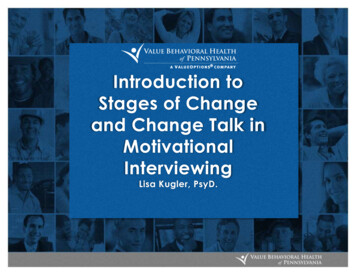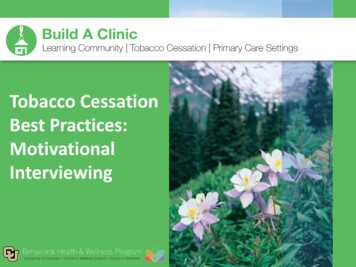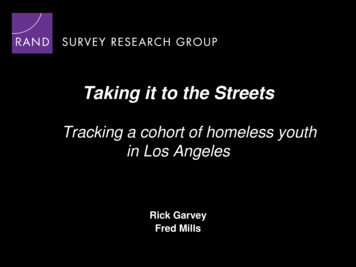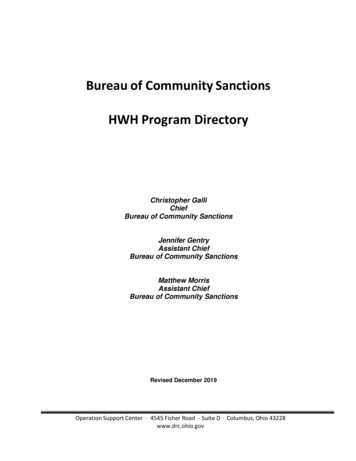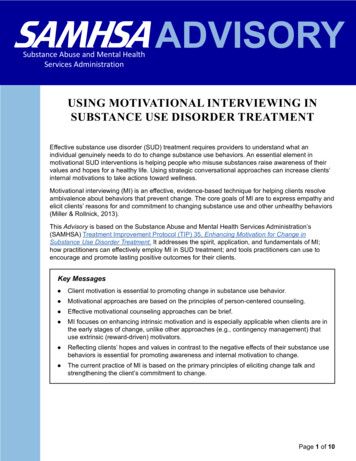
Transcription
Substance Abuse and Mental HealthServices AdministrationADVISORYUSING MOTIVATIONAL INTERVIEWING INSUBSTANCE USE DISORDER TREATMENTEffective substance use disorder (SUD) treatment requires providers to understand what anindividual genuinely needs to do to change substance use behaviors. An essential element inmotivational SUD interventions is helping people who misuse substances raise awareness of theirvalues and hopes for a healthy life. Using strategic conversational approaches can increase clients’internal motivations to take actions toward wellness.Motivational interviewing (MI) is an effective, evidence-based technique for helping clients resolveambivalence about behaviors that prevent change. The core goals of MI are to express empathy andelicit clients’ reasons for and commitment to changing substance use and other unhealthy behaviors(Miller & Rollnick, 2013).This Advisory is based on the Substance Abuse and Mental Health Services Administration’s(SAMHSA) Treatment Improvement Protocol (TIP) 35, Enhancing Motivation for Change inSubstance Use Disorder Treatment. It addresses the spirit, application, and fundamentals of MI;how practitioners can effectively employ MI in SUD treatment; and tools practitioners can use toencourage and promote lasting positive outcomes for their clients.Key Messages Client motivation is essential to promoting change in substance use behavior. Motivational approaches are based on the principles of person-centered counseling. Effective motivational counseling approaches can be brief. MI focuses on enhancing intrinsic motivation and is especially applicable when clients are inthe early stages of change, unlike other approaches (e.g., contingency management) thatuse extrinsic (reward-driven) motivators. Reflecting clients’ hopes and values in contrast to the negative effects of their substance usebehaviors is essential for promoting awareness and internal motivation to change. The current practice of MI is based on the primary principles of eliciting change talk andstrengthening the client’s commitment to change.Page 1 of 10
ADVISORYCore Principles of Motivational InterviewingMI is a goal-directed SUD intervention that stems from person-centered counseling and focuses on thecollaboration between provider and client. It is a respectful counseling style that raises awareness of aclient’s internal discrepancies about substance use, focuses on helping clients resolve their ambivalenceabout SUD, and can promote their motivation to change. Underlying this approach is the principle that aclient’s motivation to change is essential to bringing about actual change (DiClemente et al., 2017).MI is a unique counseling approach in which providers use specific clinical skills to foster client motivation tochange substance use or other unhealthy behaviors. To be effective, MI requires that providers embody thespirit of MI (i.e., the underlying perspective that there is a partnership between the provider and client thatfosters a collaborative approach to change). Providers must also become competent in both the skills andstrategies involved in MI. MI incorporates four interwoven processes: Partnership, Acceptance, Compassion,and Evocation (PACE) (Miller & Rollnick, 2013): Partnership is an active collaboration between provider and client. A client is more willing to expressconcerns when the provider is empathetic and shows genuine curiosity about the client’s perspective. Inthis partnership, the provider gently influences the client, but the client drives the conversation. Acceptance is the act of demonstrating respect for and approval of the client. It shows the provider’sintent to understand the client’s point of view and concerns. Providers can use MI’s four componentsof acceptance—absolute worth, accurate empathy, autonomy support, and affirmation—to help themappreciate the client’s situation and decisions. Compassion refers to the provider actively promoting the client’s welfare and prioritizing the client’sneeds. Evocation is the process of eliciting and exploring a client’s existing motivations, values, strengths, andresources.Practitioners can further enhance the use of MI by adapting to cultural differences, rather than making culturalassumptions about clients’ needs. Successful cultural adaptation includes identifying potential areas of conflict or“mismatches” between the planned intervention and the client’s culture and then adjusting to reflect the client’scultural norms more closely. This can be accomplished by altering such components as the language, content,concepts, goals, and/or methods employed by the practitioner (Oh & Lee, 2016).Transtheoretical Model and Stages of ChangeMI is rooted in the transtheoretical model of the stages of change framework, a process of change that hasfive stages (Connors et al., 2013): Precontemplation—Individuals currently using substances are not thinking of making a change now orin the future. Contemplation—Individuals currently using substances are aware that they need to make a change. Preparation—Individuals currently using substances begin weighing the pros and cons of making achange and preparing for how to deal with urges and triggers. Action—Individuals currently using substances decide to change their behavior and successfullyattempt to do so.Page 2 of 10SAMHSA’s mission is to reduce the impact of substance abuse and mental illness on America’s communities.1-877-SAMHSA-7 (1-877-726-4727) 1-800-487-4889 (TDD) WWW.SAMHSA.GOV
ADVISORY Maintenance—Individuals who changed their substance use behaviors are engaged in efforts tocontinue doing so over the long term.The focus of MI is on enhancing intrinsic motivation (rather than on providing the client with extrinsicmotivation, which is key to other behavioral strategies like contingency management). Providers can assistclients in developing and understanding their intrinsic motivations by helping them see “where they are”versus “where they want to be.” Intrinsic motivation is a method of moving from contemplation to preparationfor implementing change.Evolution of MI—Four Principles Versus Four ProcessesMI has evolved considerably since its initial development in the early 1990s. While prior MI applicationfocused on four principles (express empathy, develop discrepancy, roll with resistance, and support selfefficacy), MI is now based on four processes: Engaging, which is the relational foundation Focusing, which identifies an agenda and change goals Evoking, which uses MI core skills and strategies to move toward a specific change goal Planning, which is the bridge to behavior changeThe original four principles have been folded into the four processes as reflective listening or strategicresponses intended to move conversations along. These processes help practitioners frame a clinicalsession with their clients and provide specifics as outlined below.Integrating MI Approaches Into PracticeListen and interact using OARS (Asking Open questions, Affirmations,Reflective listening, Summarization)The core counseling skills of MI are described with the acronym OARS. Providers should use openquestions to invite clients to tell their story and obtain a meaningful understanding of the clients’ goals,values, and beliefs. For example, providers can ask questions such as, “What was it like when you weredrinking a 12-pack of beer every day?” or “Can you tell me a little more about how using cocaine affectedyour marriage?” (Miller & Rollnick, 2013).Using affirmation expresses genuine appreciation and confirms a positive regard for clients’ hidden andexpressed strengths (Miller & Rollnick, 2013). For example, “You got discouraged last week but kept goingto your AA meetings. You are persistent!” Or, “That’s a good idea for how you can avoid situations where youmight be tempted to drink” (Miller & Rollnick, 2013).Reflective listening is fundamental to person-centered counseling and is one of the most importantelements of MI (Miller & Rollnick, 2013). Reflections provide the client with the opportunity to verify that theprovider’s interpretation is congruent with the client’s thought or intention. Providers’ expressions of empathyare predictive of improved substance use outcomes (Moyers et al., 2016). Providers skilled in MI offerreflections more than they ask questions. As an example, the client says, “It can be really hard to deal withDave when he’s stressed and has been drinking. He sits around and won’t help out and gets upset when IPage 3 of 10SAMHSA’s mission is to reduce the impact of substance abuse and mental illness on America’s communities.1-877-SAMHSA-7 (1-877-726-4727) 1-800-487-4889 (TDD) WWW.SAMHSA.GOV
ADVISORYsay anything to him about it. Sometimes I’m late picking up the kids from school because I have no help.”The provider could respond with a meaning-reflection (“When Dave gets stressed out and drinks, he doesn’thelp you around the house, and that makes it harder for you to pick the kids up from school on time”) or afeeling-reflection (“When Dave gets stressed out and drinks, he doesn’t help around the house, which canbe very frustrating. Then, when you can’t pick the kids up on time, you feel like you’re being a bad parent”)(Miller & Rollnick, 2013).Summarization by the provider during a counseling session is a key element of reflective listening thatdistills statements that have a particular meaning for a client and reflects them back to ensure appropriateunderstanding of the client’s full experience (Miller & Rollnick, 2013). Summaries can provide a concisestatement of what was expressed, or they can guide change in the discussion theme. A summary statementcould be as follows, “Okay, let me make sure I understand. You’re interested in attending some AA meetings,but your only free time is after work, and then someone else would have to pick up the kids. Also, you havesome concerns about being able to attend meetings regularly because it sounds like your car is old andunreliable. Do I have that right?” (Miller & Rollnick, 2013). Where clinically appropriate, skilled MI providersdeliver summaries several times during a session to assure the client they heard the client’s expressions andunderstand the meaning.Distinguish between sustain talk and change talkChange talk consists of statements that favor making changes (“I have to stop smoking crack or I’m goingto land in jail again”) (Miller & Rollnick, 2013). It is normal for individuals to “feel two ways” about makingfundamental life changes. This ambivalence can be an impediment to change but does not indicate a lack ofknowledge or skills about how to change (Forman & Moyers, 2019).Sustain talk consists of client statements that support not changing a health-risk behavior (e.g., “Marijuanahas never affected me”) (Miller & Rollnick, 2013).Recognizing sustain talk and change talk in clients will help the provider better explore and addressambivalence. Studies show that encouraging, eliciting, and properly reflecting change talk is associated withbetter outcomes in client substance use behavior (Barnett et al., 2014; Borsari et al., 2018; Houck et al.,2018; Magill et al., 2014, 2018; Romano & Peters, 2016).Advance client thinking with DARN-CATProviders can remember to listen for different types of change talk using the acronym DARN-CAT: Desire,Ability, Reason, Need, Commitment, Activation, and Taking steps. Examples of practitioner questions in thismodel are summarized in the table below (Miller & Rollnick, 2013). Additional details about the DARN-CATmodel are available in TIP 35.Page 4 of 10SAMHSA’s mission is to reduce the impact of substance abuse and mental illness on America’s communities.1-877-SAMHSA-7 (1-877-726-4727) 1-800-487-4889 (TDD) WWW.SAMHSA.GOV
ADVISORYExamples of DARN-CAT StatementsDesireCommitmentStatements about preference for change:Statements about the willingness of change:“How would you like for your drinking tochange?”“I want to ”“What do you hope our work together willaccomplish?”“I need to ”“I could ”AbilityActivationStatements about capability:Statements about willingness to change:“If you decided to quit drinking, what stepswould you take?”“I am willing to ”“What do you think you might be able to changeabout your opioid use?”“I am prepared to ”“I am ready to ”“What ideas do you have for how you could stopsmoking?”ReasonsTaking StepsSpecific arguments for change:Statements about action taken:“What are some of the reasons you have forstopping smoking?”“I went to a support group meeting.”“Why would you want to stop or cut back onyour use of alcohol?”“This week, I didn’t smoke a cigarette in theevening.”“What’s the downside of you continuing to useheroin?”NeedStatements about the need to change:“What needs to happen for you to feel ready togive up cocaine?”“How important is it for you to stop smoking?”Strategies to elicit change talkMI includes a set of strategies beyond core interviewing skills that can assist providers in evoking changetalk: asking for elaboration, asking for examples, looking back, looking forward, querying extreme thoughts,measuring clients’ confidence in their ability to successfully change behaviors, and exploring goals and values.(See TIP 35 for more information.) The strategies are most effective when there is already a positive therapeuticalliance generated by a provider’s competent use of OARS. Additionally, providers should take into account theclient’s stage of change and readiness to change when selecting the most appropriate strategy.Page 5 of 10SAMHSA’s mission is to reduce the impact of substance abuse and mental illness on America’s communities.1-877-SAMHSA-7 (1-877-726-4727) 1-800-487-4889 (TDD) WWW.SAMHSA.GOV
ADVISORYEmploy the FRAMES ApproachThe FRAMES approach consists of six components designed to move patients toward self-awareness andbuild confidence in their ability to change. This method can be incorporated into screening, brief intervention,and referral to treatment (SBIRT) interactions. These components are summarized in the acronym: Feedback,Responsibility, Advice, Menu of options, Empathy, and Self-efficacy. When working with SUDs, providers should: Give clients personalized feedback from assessments so they understand how the severity of their problemcompares to others. This can include results from standardized screening or assessment instruments.Feedback can influence motivation for treatment and promote movement between stages of change. Empower clients to become involved in the change process by taking responsibility for choices theymake about their substance misuse and the effect on treatment initiation and outcomes. Seek permission to offer directive or educational advice in the form of suggestions and/or potentialactivities or processes that promote positive change. Clients can then provide feedback and ask forclarification about the provider’s suggestions. This approach requires patience and careful timing. Present choices through a menu of options to promote client engagement and facilitate treatment. Thesechoices have been shown to enhance the therapeutic alliance, decrease dropout rates, and improveoutcomes (Van Horn et al., 2015). Demonstrate empathy by taking an active interest in understanding the perspective of the client throughthe use of reflective listening (Miller & Rollnick, 2013). Provider empathy is a moderately strong predictorof client treatment outcomes (Elliott et al., 2018). Assist with the enhancement of self-efficacy by supporting the client, helping to review past successes,identifying personal strengths, and building the client’s confidence in the ability to make positive changes(Kadden & Litt, 2011). Considerable evidence points to self-efficacy as an important factor in addictiontreatment outcomes (Kadden & Litt, 2011; Kuerbis et al., 2013; Litt & Kadden, 2015; Morgensternet al., 2016).Brief MI InterventionsEffective motivational counseling approaches can be brief and conducted in a variety of settings. As partof a movement toward early identification of alcohol misuse and the development of effective and low-costmethods to address such issues, brief intervention strategies that include motivational components are widelyused in the United States and in other countries (Joseph & Basu, 2016). Research has shown positive effectsfrom screening and brief motivational interventions in clinical settings (Bernstein et al., 2005). For instance,SBIRT has been proven effective for reducing substance use and misuse among adolescents and adults. MItechniques are a fundamental part of SBIRT interactions.Learn more about how to use MI with SBIRT for clients with substance misuse in TIP 35.Using Motivational Approaches With SUD ClientsMotivational approaches can help clients with SUDs achieve better outcomes. SUD research hasconsistently shown that MI can help reduce alcohol use and misuse, tobacco use, and drug use (Madsonet al., 2016; SAMHSA, 2019). Other positive outcomes associated with MI interventions include improvedretention in SUD treatment following detoxification, improved retention in methadone maintenance programs,and greater engagement in HIV risk-reduction behaviors (Bachiller et al., 2015; D’Amico et al., 2015; Holstadet al., 2010; Navidian et al., 2016).Page 6 of 10SAMHSA’s mission is to reduce the impact of substance abuse and mental illness on America’s communities.1-877-SAMHSA-7 (1-877-726-4727) 1-800-487-4889 (TDD) WWW.SAMHSA.GOV
ADVISORYMI can be offered as an effective, independent treatment or as a part of other evidence-based interventions(Madson et al., 2016). When used with cognitive–behavioral therapy, for instance, MI for people with SUDsmay help increase the odds of clients maintaining long-term positive behavior changes (Copeland et al.,2017; Naar & Safren, 2017). Making MI part of SUD treatment intake and assessment improves retentionin SUD treatment and length of abstinence (Martino et al., 2016). MI has been shown to be effective in awide variety of client populations, such as adolescents, women with HIV, people in criminal justice settings(including youth in juvenile corrections settings), people with SUDs and co-occurring mental disorders,college students, and other young adults (Madson et al., 2016; SAMHSA, 2019). Finally, research suggestsMI can be applied in both individual as well as group formats, although more research is needed on the latter(Madson et al., 2016).MI Fidelity—Adherence and Proficiency for Better OutcomesFidelity to an evidence-based practice is defined by two components: adherence (i.e., delivering theintervention as prescribed by the developers in the manual or guide) and competence (i.e., the skillfulnesswith which the primary intervention components are delivered) (Schillinger, 2010). MI is considered acomplex skill that requires practice as well as the provider’s focus on integrating the MI spirit, skills, andstrategies. MI adherence and competence can be learned most effectively by receiving coaching andfeedback from MI-competent supervisors, by attending to the reactions and success of clients, and throughMI-focused learning collaboratives. Providers can adhere to MI principles by refraining from giving toomuch advice and asking too many questions without reflections. Further, providers should be careful thatthey do not disregard clients’ efficacy by neglecting to affirm their positive actions. Research supports theeffectiveness of MI training in improving provider knowledge and application of motivational techniques(Madson et al., 2016).Resources Substance Abuse and Mental Health Services Administration (SAMHSA)̛ Screening, Brief Intervention, and Referral to Treatment (SBIRT)̛ TIP 35, Enhancing Motivation for Change in Substance Use Disorder Treatment̛ Addiction Technology Transfer Center Network Motivational Interviewing Trainings Boston University School of Public Health, BNI ART Institute Institute for Research, Education & Training in Addictions (IRETA)̛ Motivational Interviewing Toolkit Motivational Enhancement Therapy Manual Motivational Interviewing Network of Trainers (MINT)̛ Motivational Interviewing Resources National Institute on Drug Abuse (NIDA)̛ Blending Initiative Motivational Interviewing CME/CE and Patient Simulation Providers Clinical Support System’s Motivational Interviewing: Talking with Someone Strugglingwith Opioid AddictionPage 7 of 10SAMHSA’s mission is to reduce the impact of substance abuse and mental illness on America’s communities.1-877-SAMHSA-7 (1-877-726-4727) 1-800-487-4889 (TDD) WWW.SAMHSA.GOV
ADVISORYBibliographyBachiller, D., Grau-López, L., Barral, C., Daigre, C., Alberich, C., Rodríguez-Cintas, L., Roncero, C. (2015).Motivational interviewing group at inpatient detoxification: Its influence in maintaining abstinence and treatmentretention after discharge. Adicciones, 27(2), 109–118.Barnett, E., Moyers, T. B., Sussman, S., Smith, C., Rohrbach, L. A., Sun, P., & Spruijt-Metz, D. (2014). From counselorskill to decreased marijuana use: Does change talk matter? Journal of Substance Abuse Treatment, 46, 498–505.Bernstein, J., Bernstein, E., Tassiopoulos, K., Heeren, T., Levenson, S., & Hingson, R. (2005). Brief motivationalintervention at a clinic visit reduces cocaine and heroin use. Drug and Alcohol Dependence, 77(1), 49–59.Borsari, B., Apodaca, T. R., Jackson, K. M., Fernandez, A., Mastroleo, N. R., Magill, M., Carey, K. B. (2018).Trajectories of in-session change language in brief motivational interventions with mandated college students. Journalof Consulting and Clinical Psychology, 86(2), 158–168.Connors, G. J., DiClemente, C. C., Velasquez, M. M., & Donovan, D. M. (2013). Substance abuse treatment and thestages of change: Selecting and planning interventions (2nd ed.). Guilford.Copeland, J., Gates, P., & Pokorski, I. (2017). A narrative review of psychological cannabis use treatments with andwithout pharmaceutical adjunct. Current Pharmaceutical Design, 22(42), 6397–6408.D’Amico, E. J., Houck, J. M., Hunter, S. B., Miles, J. N., Osilla, K. C., & Ewing, B. A. (2015). Group motivationalinterviewing for adolescents: Change talk and alcohol and marijuana outcomes. Journal of Consulting and ClinicalPsychology, 83(1), 68–80.DiClemente, C. C., Corno, C. M., Graydon, M. M., Wiprovnick, A. E., & Knoblach, D. J. (2017). Motivational interviewing,enhancement, and brief interventions over the last decade: A review of reviews of efficacy and effectiveness.Psychology of Addictive Behaviors, 31(8), 862–887.Elliott, R., Bohart, A. C., Watson, J. C., & Murphy, D. (2018). Therapist empathy and client outcome: An updated metaanalysis. Psychotherapy, 55(4), 399–410.Forman, D. P., & Moyers, T. B. (2019). With odds of a single session, motivational interviewing is a good bet.Psychotherapy, 56(1), 62–66.Holstad, M. M., Diiorio, C., Kelley, M. E., Resnicow, K., & Sharma, S. (2010). Group motivational interviewing topromote adherence to antiretroviral medications and risk reduction behaviors in HIV infected women. AIDS andBehavior, 15(5), 885–896.Houck, J. M., Manuel, J. K., & Moyers, T. B. (2018). Short- and long-term effects of within-session client speech ondrinking outcomes in the COMBINE study. Journal of Studies on Alcohol and Drugs, 79(2), 217–222.Joseph, J., & Basu, D. (2016). Efficacy of brief interventions in reducing hazardous or harmful alcohol use in middleincome countries: Systematic review of randomized controlled trials. Alcohol and Alcoholism, 52(1), 56–64.Kadden, R. M., & Litt, M. D. (2011). The role of self-efficacy in the treatment of substance use disorders. AddictiveBehaviors, 36(12), 1120–1126.Kuerbis, A., Armeli, S., Muench, F., & Morgenstern, J. (2013). Motivation and self-efficacy in the context of moderateddrinking: Global self-report and ecological momentary assessment. Psychology of Addictive Behaviors, 27(4), 934–943.Litt, M. D., & Kadden, R. M. (2015). Willpower versus “skillpower”: Examining how self-efficacy works in treatment formarijuana dependence. Psychology of Addictive Behaviors, 29(3), 532–540.Madson, M., Schumacher, J., Baer, J. & Martino, S. (2016). Motivational interviewing for substance use: Mapping outthe next generation of research. Journal of Substance Abuse Treatment, 65, 1–5.Magill, M., Apodaca, T. R., Borsari, B., Gaume, J., Hoadley, A., Gordon, R. E. F., Moyers, T. (2018). A meta-analysisof motivational interviewing process: Technical, relational, and conditional process models of change. Journal ofConsulting and Clinical Psychology, 86(2), 140–157.Page 8 of 10SAMHSA’s mission is to reduce the impact of substance abuse and mental illness on America’s communities.1-877-SAMHSA-7 (1-877-726-4727) 1-800-487-4889 (TDD) WWW.SAMHSA.GOV
ADVISORYMagill, M., Gaume, J., Apodaca, T. R., Walthers, J., Mastroleo, N. R., Borsari, B., & Longabaugh, R. (2014). Thetechnical hypothesis of motivational interviewing: A meta-analysis of MI’s key causal model. Journal of Consulting andClinical Psychology, 82(6), 973–983.Martino, S., Paris, M., Añez, L., Nich, C., Canning-Ball, M., Hunkele, K., Carroll, K. M. (2016). The effectiveness andcost of clinical supervision for motivational interviewing: A randomized controlled trial. Journal of Substance AbuseTreatment, 68, 11–23.Miller, W. R., & Rollnick, S. (2013). Motivational interviewing: Helping people change (3rd ed.). Guilford.Morgenstern, J., Kuerbis, A., Houser, J., Muench, F. J., Shao, S., & Treloar, H. (2016). Within-person associationsbetween daily motivation and self-efficacy and drinking among problem drinkers in treatment. Psychology of AddictiveBehaviors, 30(6), 630–638.Moyers, T. B., Houck, J., Rice, S. L., Longabaugh, R., & Miller, W. R. (2016). Therapist empathy, combined behavioralintervention, and alcohol outcomes in the COMBINE research project. Journal of Consulting and Clinical Psychology,84(3), 221–229.Naar, S., & Safren, S. A. (2017). Motivational interviewing and CBT: Combining strategies for maximum effectiveness.Guilford.Navidian, A., Kermansaravi, F., Tabas, E. E., & Saeedinezhad, F. (2016). Efficacy of group motivational interviewing inthe degree of drug craving in the addicts under the methadone maintenance treatment (MMT) in South East of Iran.Archives of Psychiatric Nursing, 30(2), 144–149.Oh, H., & Lee, C. (2016). Culture and motivational interviewing. Patient Education and Counseling, 99(11), 1914–1919.Romano, M., & Peters, L. (2016). Understanding the process of motivational interviewing: A review of the relational andtechnical hypotheses. Psychotherapy Research, 26(2), 220–240.Schillinger, D. (2010). An introduction to effectiveness, dissemination and implementation research. ClinicalTranslational Science Institute Community Engagement Program.Substance Abuse and Mental Health Services Administration. (2019). Enhancing motivation for change in substanceuse disorder treatment. Treatment Improvement Protocol (TIP) Series No. 35. SAMHSA Publication No. PEP19-0201-003.Van Horn, D. H., Drapkin, M., Lynch, K. G., Rennert, L., Goodman, J. D., Thomas, T., McKay, J. R. (2015). Treatmentchoices and subsequent attendance by substance-dependent patients who disengage from intensive outpatienttreatment. Addiction Research and Theory, 23(5), 391–403.Page 9 of 10SAMHSA’s mission is to reduce the impact of substance abuse and mental illness on America’s communities.1-877-SAMHSA-7 (1-877-726-4727) 1-800-487-4889 (TDD) WWW.SAMHSA.GOV
ADVISORYAcknowledgments: This Advisory was written and produced under contract number 283-17-4901 by theKnowledge Application Program (KAP) for the Substance Abuse and Mental Health Services Administration(SAMHSA), U.S. Department of Health and Human Services (HHS). Dr. Robert Baillieu served as ProductChampion, and Suzanne Wise served as the Contracting Officer’s Representative (COR).Nondiscrimination Notice: SAMHSA complies with applicable federal civil rights laws and does notdiscriminate on the basis of race, color, national origin, age, disability, or sex. SAMHSA cumple con lasleyes federales de derechos civiles aplicables y no discrimina por motivos de raza, color, nacionalidad,edad, discapacidad, o sexo.Recommended Citation: Substance Abuse and Mental Health Services Administration. (2021). UsingMotivational Interviewing in Substance Use Disorder Treatment. Advisory.Publication No. PEP20-02-02-014Published 2021SAMHSA PUBLICATION NO. PEP20-02-02-0141-877-SAMHSA-7 (1-877-726-4727) 1-800-487-4889 (TDD) WWW.SAMHSA.GOV
Motivational interviewing (MI) is an effective, evidence-based technique for helping clients resolve . ambivalence about behaviors that prevent change. The core goals of MI are to express empathy and elicit clients’ reasons for and commitment to changing substance use and other unhealth


